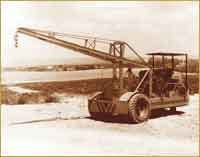In 1947, John Landis Grove, together with his brother Dwight and partner Wayne Nicarry, established Grove Manufacturing in the village of Shady Grove, Pa. Located in a rented two-car garage, the firm's initial business was manufacturing farm wagons. After an unsuccessful search for a small commercial yard-type crane to lift steel plates, the company built its own mobile crane in 1949.
The 2-ton-capacity crane was built on a three-wheel frame with steering actuated by the single rear wheel, and propulsion provided by the two front wheels. A simple twin-cylinder hydraulic hoist raised and lowered the boom to which the load was attached. Although crude by today's standards, the unit not only met the needs of its inventor, but also attracted a lot of attention from local businesses that could see its potential.
Realizing there was a market for small yard cranes, Grove refined his 2-ton machine and introduced it to the marketplace. Word soon spread and, by 1955, Grove was supplying hydraulic cranes to dozens of neighboring businesses.
In that year the company split, with Dwight Grove taking the farm-wagon division and John staying with the crane-manufacturing division. Over the next 12 years, John Grove grew his company into one of the largest crane manufacturers in the world. Grove unveiled its first rough-terrain crane and its first truck crane in 1959 and, in 1965, shipped its 1,000th crane.
In 1967, J.L. Grove sold his interest in the company and decided to take time out and travel. But he could never detach himself completely from the lifting industry and kept in touch with his many friends, colleagues and customers from his time at Grove. He shortly returned to the industry, helping to found aerial-work-platform manufacturer JLG in 1969. He retired from JLG in 1993 after seeing the company grow into one of the leaders in the aerial-platform market.
Meanwhile, Grove rapidly grew and prospered, shipping its 20,000th crane in 1979, and its 50,000th in 1997, the year the company celebrated its 50th anniversary. Along the way, Grove took under its wing a number of well-known lifting manufacturers including: National Crane, a leading manufacturer of truck-mounted hydraulic boom cranes, in 1978; Coles Cranes of England, Europe's largest crane manufacturer, in 1984; and in 1995, Krupp's mobile hydraulic crane business based in Germany, adding 14 all-terrain cranes to Grove's product line. Grove's corporate identity was changed to Grove Worldwide in 1990.
In 2002, Grove Worldwide became a division of Manitowoc Crane Group, but the Grove name lives on. Its brand name continues unchanged under the new parent company.
J.L. Grove died in June 2003 at the age of 82. But the Grove brand serves as a tribute to the man who started with a simple crane built to fill a personal need.
You can read more about the evolution of construction equipment in Keith Haddock's illustrated book "The Earthmover Encyclopedia" available in most bookstores. Also, consider a membership in the Historical Construction Equipment Association, www.hcea.net.




